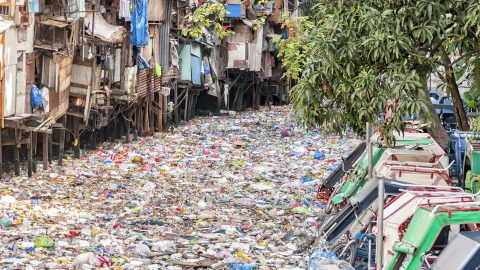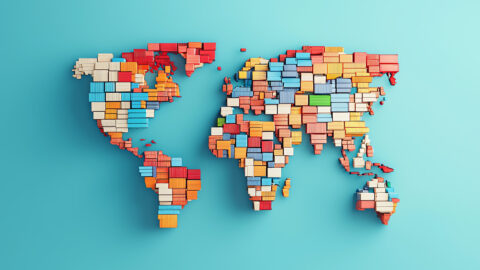The world consumes resources more quickly and at larger quantities than our population is growing: in 2050, more than 9bn people with three times today’s per capita income will form the basis of demand for natural resources. The OECD therefore regards the doubling of today’s material input as realistic. The global plastics production reflects this very situation: according to data provided by the International Organisation for Standardisation, said production amounted to 322mn tonnes in 2015 and had thus increased by a factor of 20x since 1964. For the coming 20 years, a further doubling is expected, with plastic packaging making up the lion’s share.
Plastic comes with a vast array of uses: plastic packaging can be used to prolong durability and can thus cut down on food waste. Also, lighter packaging saves fuel in transport. However, problems arise at the back end of the process: only 14% of packaging is recycled (by comparison, paper has a recycling rate of 58%, and steel and iron has one of 70-90%). The material also loses in value through sorting and treatment, as a result of which only 5% of material value remains in existence. This means that about USD 80 to 120bn are lost every year.
More plastic than fish
90% of the production of plastic is based on fossil energy carriers; it could account for 20% of total oil consumption in 2050. In addition, 32% of plastic packaging exits the system without control and ends up for example in the ocean. The MacArthur Foundation estimates the costs of emissions and affected ecosystems at an annual USD 40bn.
The plastic contamination of the sea causes environmental problems: some 8 tonnes are dumped in the oceans every year, which has led to a total amount of plastic of 150 tonnes currently floating in the sea. At constant rates of contamination and measured in kilo, there might be more plastic than fish in the oceans by 2050. The environmental damage is grave: at the moment, some 1,400 animal species living in or close to the sea are affected or contaminated by plastic waste. “We assume that by 2050 almost all marine birds will have plastic particles in their stomachs; the natural habitat such as coral reefs are also damaged by plastic waste deposits,” explains Georg Scattolin, Head of International Programme, WWF Austria.
Plastic particles can remain in the environment for up to 400 years and may also enter the human food chain. Microplastics have been found in fish, mussels, crayfish, and table salt.
Enzymes against plastic waste
Several solutions have been discussed, for example an enzyme that can degrade plastic effectively. This enzyme was discovered by a Japanese team in 2016 and analysed for its structure by English scientists. This accidentally spawned an optimised version that facilitated the breaking of long polyethylene terephthalate (PET) chains. However, in order to make its industrial use possible, the process speed will still have to be ramped up.
The Austrian Centre of Industrial Biotechnology has engaged in research on plastic-degrading enzymes since 2001 as well. The fundamental problem of classic recycling, i.e. the fact that in terms of quality the recycled material does not hold a candle to the original material, is to be solved by the use of enzymes. PET materials of similar quality could be produced, which would cut the degradation process from 400 years to 3-4 weeks.
Legal disclaimer
This document is an advertisement. Unless indicated otherwise, source: Erste Asset Management GmbH. The language of communication of the sales offices is German and the languages of communication of the Management Company also include English.
The prospectus for UCITS funds (including any amendments) is prepared and published in accordance with the provisions of the InvFG 2011 as amended. Information for Investors pursuant to § 21 AIFMG is prepared for the alternative investment funds (AIF) administered by Erste Asset Management GmbH pursuant to the provisions of the AIFMG in conjunction with the InvFG 2011.
The currently valid versions of the prospectus, the Information for Investors pursuant to § 21 AIFMG, and the key information document can be found on the website www.erste-am.com under “Mandatory publications” and can be obtained free of charge by interested investors at the offices of the Management Company and at the offices of the depositary bank. The exact date of the most recent publication of the prospectus, the languages in which the fund prospectus or the Information for Investors pursuant to Art 21 AIFMG and the key information document are available, and any other locations where the documents can be obtained are indicated on the website www.erste-am.com. A summary of the investor rights is available in German and English on the website www.erste-am.com/investor-rights and can also be obtained from the Management Company.
The Management Company can decide to suspend the provisions it has taken for the sale of unit certificates in other countries in accordance with the regulatory requirements.
Note: You are about to purchase a product that may be difficult to understand. We recommend that you read the indicated fund documents before making an investment decision. In addition to the locations listed above, you can obtain these documents free of charge at the offices of the referring Sparkassen bank and the offices of Erste Bank der oesterreichischen Sparkassen AG. You can also access these documents electronically at www.erste-am.com.
Our analyses and conclusions are general in nature and do not take into account the individual characteristics of our investors in terms of earnings, taxation, experience and knowledge, investment objective, financial position, capacity for loss, and risk tolerance. Past performance is not a reliable indicator of the future performance of a fund.
Please note: Investments in securities entail risks in addition to the opportunities presented here. The value of units and their earnings can rise and fall. Changes in exchange rates can also have a positive or negative effect on the value of an investment. For this reason, you may receive less than your originally invested amount when you redeem your units. Persons who are interested in purchasing units in investment funds are advised to read the current fund prospectus(es) and the Information for Investors pursuant to § 21 AIFMG, especially the risk notices they contain, before making an investment decision. If the fund currency is different than the investor’s home currency, changes in the relevant exchange rate can positively or negatively influence the value of the investment and the amount of the costs associated with the fund in the home currency.
We are not permitted to directly or indirectly offer, sell, transfer, or deliver this financial product to natural or legal persons whose place of residence or domicile is located in a country where this is legally prohibited. In this case, we may not provide any product information, either.
Please consult the corresponding information in the fund prospectus and the Information for Investors pursuant to § 21 AIFMG for restrictions on the sale of the fund to American or Russian citizens.
It is expressly noted that this communication does not provide any investment recommendations, but only expresses our current market assessment. Thus, this communication is not a substitute for investment advice.
This document does not represent a sales activity of the Management Company and therefore may not be construed as an offer for the purchase or sale of financial or investment instruments.
Erste Asset Management GmbH is affiliated with the Erste Bank and austrian Sparkassen banks.
Please also read the “Information about us and our securities services” published by your bank.


